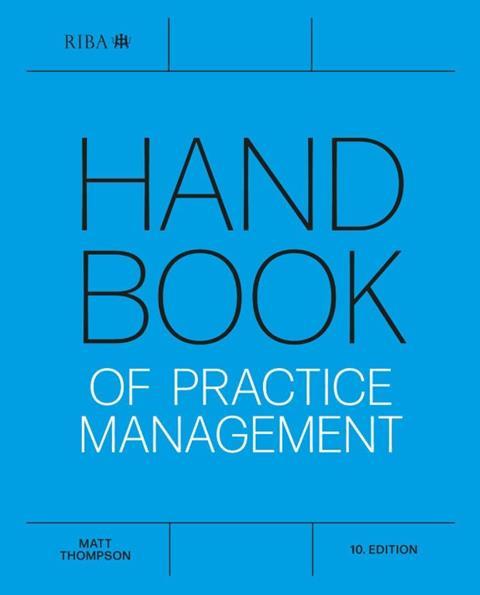The fully revised 10th edition is intended as a ‘primer for people running businesses’, writes Matt Thompson

Back in 2022, I was invited to take on the role of managing editor to update the RIBA’s flagship title, RIBA Handbook of Practice Management, for a tenth edition.
Although the book had been reprinted with slight revisions in 2016, the last proper new edition had been way back in 2013. As they say, a lot of water had gone under the bridge since then.
Think of it: the nation was still basking in the rosy afterglow of the London 2012 Olympics. The global financial crisis triggered by the US subprime mortgage crisis was still niggling away but green shoots of recovery were visible. Indeed, the design economy was booming. According to a 2013 Design Council report, the architecture and built environment sector’s GVA had grown 25% since 2009.
Those were the days, eh? All the shocks of the late 2010s had yet to happen. Leaving the European Union was unthinkable. Grenfell Tower was just another anonymous housing block. Global pandemics and AI were still the stuff of schlock horror movies and science fiction. George Floyd was a name without resonance. Russia was a known menace but had yet to annex Crimea, let alone start a war in Ukraine that triggered a global energy crisis.
Fast forward to 2022 and the world had become a worryingly – but also fascinatingly – different place, and its ripples had reached far and wide – even into architectural practice management. I accepted the job.
Running a business of any size amid constant change is fiendishly demanding
My first task was to list all the topics that would need updating, and it was a lot. As well as all the socio-economic impacts from events external to the profession, there had been massive internal churn.
ARB and RIBA had updated their codes. There was a new Plan of Work. Competence was under scrutiny. The #workingfromhome revolution was here to stay. Transforming Construction’s agenda was playing out, affecting business models. Information management, not just in relation to BIM but also data protection, had matured and evolved. Human resources issues and the battle for talent had undergone a workers’ rights, EDI revolution. Liability and PII, perennially thorny, were drawing blood.

Knowing I couldn’t possibly cover all these topics accurately by myself, the publisher and I recruited a handful of acknowledged experts from within the profession to help. Some updated whole sections; others provided a general steer. I owe them all a debt of gratitude.
So, what’s different about our new edition and why should you read it?
First, as far as possible in a book written well over a year and a half ago, it brings the story up to date, accounting for changes in legislation, practice and contemporary thinking. Barely a single topic from the ninth edition has survived unscathed: the influence of digital technologies, culture change, and macro-economic, political turmoil has been overwhelming.
Second, its focus and scope are sharper than ever before. We are clear that this new edition is a primer for people running businesses that sell building design services in the UK. Although we extend this target readership to include Part 3 architecture students, the book is not about project work or the body of professional knowledge. It is rooted in a commercial context; it’s about managing a business. This seems important for a profession stereotyped as bad at running businesses.
Third, it tries to distinguish, as clearly as possible, between the three Cs: compliance, conformance, and competitiveness. Compliance is what is required of you by law. This is ever-changing and complex, and so of course is only outlined in broad brushstrokes. Conformance is what is expected of you by the ARB and RIBA codes and various other constraining conditions, not least insurance provisions. And competitiveness is all about the strategies, tactics and tools available to you for commercial advantage – i.e., to thrive and, hopefully, achieve your business vision. The idea is that this categorisation will help readers to clarify business priorities.
By chunking the process of practice management up into digestible topics, all within an overarching framework aimed at lessening the load, I hope it serves its readership well
Overall, we tried hard to improve the consistency of tone and depth of detail in the book. Previous editions had been updated piecemeal, and the joins were beginning to show. This one has been completely rewritten, with extensive references for anyone who wants to find out more.
Running a business of any size amid constant change is fiendishly demanding when there is fee-earning project work to complete. Although many British building designers manage this balancing act perfectly well, too many others flounder. The old culprits of a misaligned education and a society that does not value design highly enough leave them unprepared and unable to resist the race to the bottom.
This new edition can’t fix those foundations, but it can help. By chunking the process of practice management up into digestible topics, all within an overarching framework aimed at lessening the load, I hope it serves its readership well.
>> Also read: Architecture is a business. So why don’t architects act like business people?
Postscript
The 10th edition of the RIBA Handbook of Practice Management will be published by RIBA Publishing in July.
Matt Thompson is a writer and communications consultant specialising in the built environment and the public sector. He is director of Matt Thompson Communications.













No comments yet